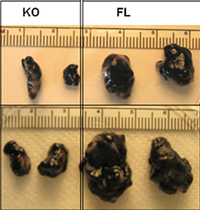
Proton-sensing G protein-coupled receptors are transmembrane receptors which sense acidic pH and include GPR132 (G2A), GPR4, GPR68 (OGR1) and GPR65 (TDAG8). These G protein-coupled receptors are activated when extracellular pH falls into the range of 6.4-6.8 (typical values are above 7.0). The functional role of the low pH sensitivity of the proton-sensing G protein-coupled receptors is being studied in several tissues where cells respond to conditions of low pH including bone and inflamed tissues. The four known proton-sensing G protein-coupled receptors are Class A receptors in subfamily A15.
Nociception
Pain sensation can be initiated by nociceptor cells that are sensory neurons with cell bodies located in the dorsal root ganglia. Some nociceptors respond to low pH and the pH-sensitive amiloride-sensitive cation channel 3 has been described as a modulator of acid-induced pain sensation. However, results with amiloride-sensitive cation channel 3 gene knockout mice suggest that those channels do not fully account for acid-induced pain sensation. Proton-sensing G protein-coupled receptors have been shown to be expressed in small-diameter neurons responsible for nociception where they may play a role in acid-induced pain sensation. Acid-sensing neuron-mediated immediate pungent pain has been associated with acid-sensing ion channels.
Other functions

Mice lacking each of the four identified proton-sensing GPCRs have been studied. Results so far suggest that these GPCRs might regulate cell proliferation (immune system cells such as lymphocytes and macrophages), but due to redundancy and expression of multiple proton-sensing GPCRs family members in the same cell, multiple gene knockouts are needed. Results for mice lacking OGR1 suggested a possible role for proton-sensing GPCRs in osteoclasts.
References
- Wang JQ, Kon J, Mogi C, Tobo M, Damirin A, Sato K, Komachi M, Malchinkhuu E, Murata N, Kimura T, Kuwabara A, Wakamatsu K, Koizumi H, Uede T, Tsujimoto G, Kurose H, Sato T, Harada A, Misawa N, Tomura H, Okajima F (2004). "TDAG8 is a proton-sensing and psychosine-sensitive G-protein-coupled receptor". J Biol Chem. 279 (44): 45626–45633. doi:10.1074/jbc.M406966200. PMID 15326175.
- Seuwen K, Ludwig MG, Wolf RM (2006). "Receptors for protons or lipid messengers or both?". J. Recept. Signal Transduct. Res. 26 (5–6): 599–610. doi:10.1080/10799890600932220. PMID 17118800. S2CID 2730341.
- Chen CC, Zimmer A, Sun WH, Hall J, Brownstein MJ, Zimmer A (2002). "A role for ASIC3 in the modulation of high-intensity pain stimuli". Proc Natl Acad Sci U S A. 99 (13): 8992–7. Bibcode:2002PNAS...99.8992C. doi:10.1073/pnas.122245999. PMC 124411. PMID 12060708.
- Yen YT, Tu PH, Chen CJ, Lin YW, Hsieh ST, Chen CC (2009). "Role of acid-sensing ion channel 3 in sub-acute-phase inflammation". Molecular Pain. 5 (1): 1. doi:10.1186/1744-8069-5-1. PMC 2632618. PMID 19126241.
- Huang CW, Tzeng JN, Chen YJ, Tsai WF, Chen CC, Sun WH (2007). "Nociceptors of dorsal root ganglion express proton-sensing G-protein-coupled receptors" (PDF). Mol. Cell. Neurosci. 36 (2): 195–210. doi:10.1016/j.mcn.2007.06.010. PMID 17720533. S2CID 38351962.
- Bessac, B. F.; Jordt, S. -E. (2010). "Sensory Detection and Responses to Toxic Gases: Mechanisms, Health Effects, and Countermeasures". Proceedings of the American Thoracic Society. 7 (4): 269–277. doi:10.1513/pats.201001-004SM. PMC 3136963. PMID 20601631.
- ^ Li H, Wang D, Singh LS, Berk M, Tan H, Zhao Z, Steinmetz R, Kirmani K, Wei G, Xu Y (2009). Aziz SA (ed.). "Abnormalities in Osteoclastogenesis and Decreased Tumorigenesis in Mice Deficient for Ovarian Cancer G Protein-Coupled Receptor 1". PLOS ONE. 4 (5): e5705. Bibcode:2009PLoSO...4.5705L. doi:10.1371/journal.pone.0005705. PMC 2684630. PMID 19479052.